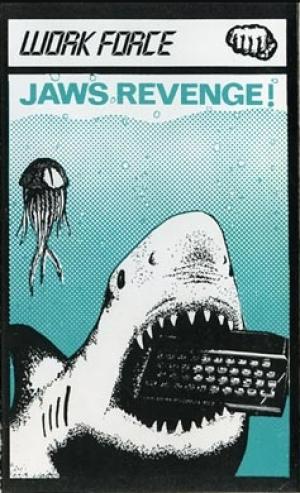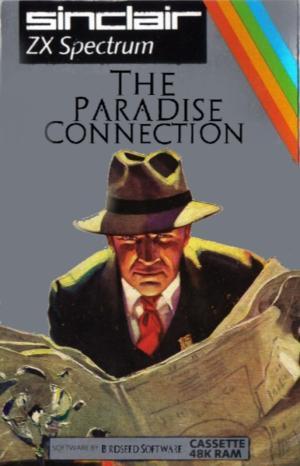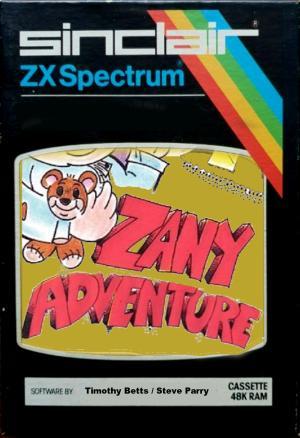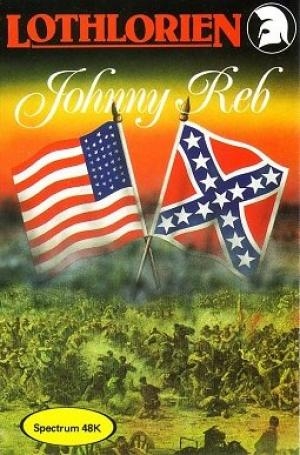
| Console: | Sinclair ZX Spectrum |
| TV Standard: | Region Not Set |
| Publisher(s): | M.C. Lothlorien |
| Release Date: | 1983-09-13 |
| Co-op: | No |
JOHNNY REB
Setting and Objective
This is a game for either one or two players, though whichever version is
being followed, the playing instructions will be very similar. The game is set
during the American Civil War and represents a skirmish around a river
crossing between Union and Confederate forces. The objective of the game is to
either capture the enemy's flag or else to achieve the more dominant tactical
position within the time period which you allow yourself.
B. Initial Setting Up
1. The first decision is whether the game is for two different players, using
the computer as the impartial umpire, or as a game for one player where the
computer will take the role of Player 2.
2. Choosing sides - Player 1 must enter which army he wishes to be, either c
(Confederate) or u (Union). In all subsequent actions Player 1 will always
move first, and in the one player game you will always be Player 1, having the
black pieces on the right hand side of the screen.
3. Setting a time limit - If you wish to play the game through to a conclusion
then enter "n" and the battle will continue until one flag has been captured.
If you enter "y" a time limit will be imposed of a given number of game turns.
Hence, after entering "y", you must enter the number of game turns you wish to
play, (a game turn is one complete cycle of movement from each player). After
the expiry of the limit the computer will calculate the respective positions
and determine the result.
4. Choosing your troops - This is always done first by Player 1 who has a
maximum limit of twenty pieces of each unit (infantry, cavalry and artillery).
You are advised that choosing such a maximum force will normally result in a
long game if you are not using the time limit. An interesting game should
result, initially, from using 8-10 units in total. Your initial selection
together with its points total using the formula, infantry = 3, cavalry = 5,
and artillery = 2, will now be displayed on the screen. You must now either
input "y" if you wish to fight with this combination or "n" which will enable
you to reselect the force. It is now the turn of either the computer or Player
2 to select their forces. To balance Player 1's advantage of first move there
is no limit set upon Player 2 as to the number of each unit he may have.
Instead, using the above points formula he merely has to construct his force
to a value no greater than the points total of Player 1. (In the one player
game you have the option of specifying that the enemy must have an identical
force to yourself. In the two player version, Player 2 also has the option of
reconsidering his initial selection). In play, Player 1 has black pieces
whilst Player 2 has the white pieces.
C. The Play
1. The Battlefield - Before choosing your forces as described in B4 above the
computer will have constructed the battlefield. The position of the river will
vary every game but the bridge will always be in a roughly similar location.
The position of the two flags will also vary each game, but Player 1 will
always be on the right and Player 2 on the left. Two other symbols also appear
at varying positions on the map. These are:-
\|/ Marshland (impenetrable) O Forest (impenetrable)
--- |
After the initial selection has taken place, your troops will be placed
randomly on your own side of the screen. (Note because of the varying river
position it is quite possible to start the game with some of your units
already on the enemy side of the river).
2. Movement Commands - In each game turn Player 1 must give commands for all
his units, after which the results of any artillery fire are calculated,
before Player 2 is able to make any of his moves. After Player 2 has made all
his moves then it is at this stage that the results of any direct attacks on
any units are calculated. Your units must be moved in the sequence in which
they flash. The unit for which a movement command is required will continue to
flash until the order has been received, so that it may be clearly identified.
The input of "q" enables you to pass the remaining moves for all your units
who have not already received a movement command and passes the move to the
other player. Pressing "ENTER" will enable you to bypass an individual unit.
a) Move (m) - You can move in one of 8 directions n, s, e, w, ne, nw, se, and
sw. All movement commands must contain three elements, the move command (m),
the direction using the above compass points and the number of squares to be
moved. (You are always told the maximum that any unit can move). A unit can
only move in one direction at any one time. In the one player version,
however, the computer is allowed moves in more than one direction. Example of
valid input = mse2.
b) Fire (f) - Instead of moving, an artillery unit can elect to fire. Again a
valid input has three elements, the fire command (f), direction using the
eight compass points and range (number of squares). Example of valid input =
fnw15.
c) Crossing river (cross) - It is possible to cross the river other than by
the bridge. Differnt parts of the river are harder than others to cross and
after crossing there is always some reduction in the unit's fighting strength.
In certain parts the loss of strength is so great that you will lose the unit
by drowning. To cross the river your unit must be directly adjacent to the
river and you must input the command "cross" when a movement is requested.
d) Limits to moves - Where an invalid request is made for a movement or the
unit reaches an impenetrable square then the movement will stop and a message
will be reported. An invalid move entry e.g. to cross the river when the unit
is not on the river bank will forfeit your move for that unit. Once entered
moves cannot be altered.
e) Saving the game (save) - If you input the letters "save" you will
automatically be able to save a part completed game onto a blank cassette. All
variables will be retained and the battlefield layout will be saved as a
SCREEN$. Verification of the recording is provided for and the command can
also be used to try out a number of different tactics from a given situation.
3. Attacking
a) Artillery fire - See para 2b for details. From time to time you will
receive ammunition status reports for your artillery and it should be noted
that whilst your initial supply of ammunition is limited you may receive
occasional resupply during the game. (In the one player version, the computer
has an unlimited supply of ammunition. In addition to help identify the gun
from the computer controlled army, the unit will continue to flash until the
shot hits its target). An exploding shot covers more than one square and hence
the subsequent reports of the results of artillery fire will be given in
sequence for each unit affected. Therefore, one artillery round may result in
three or four hits on enemy units, but you cannot his your own units.
b) Attacking an enemy unit - Attacks can be made by any unit on any other
enemy unit, by simply moving to an adjacent square. More than one unit can
attack a single enemy unit and the outcome of the encounter is determined
partly by the original status value of the units and partly by their current
remaining strengths. This confrontation result is only calculated after the
completion of the game turn of both players.
c) Unit strength - Each unit is shown against a background colour which
indicates its strength. (The lighter the colour the stronger the unit). After
any move or encounter which reduces a unit's strength the background colour
will darken using the sequence on the keys 5-1. This means that a background
colour of green will not be visible against the gren of the land area of the
map. Once a unit reaches zero strength it is removed from the battlefield.
d) Completion of game turn - The final action before the start of the next
game turn is for the computer to check the new position of each unit and these
will flash in turn as the check is made.
D. Game End
1. Expiry of Time Period - The calculation of the result is on a points table
as follows:-
a) 1 point for each item of strength remaining for each unit.
b) A points calculation based on the proximity of each unit to the enemy flag
(approx. 1/6 point per unit per square).
c) A points calculation for the safety of your own flag, as a reciprocal to b)
above.
The higher points total is the victor.
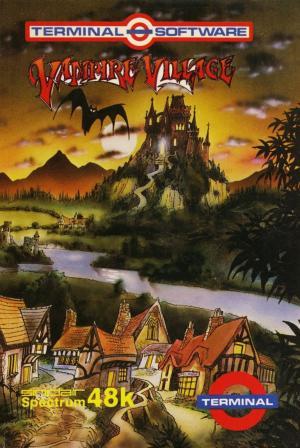


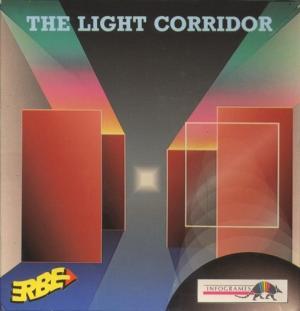
![Planetoids [ROM Cartridge]](https://gm.egamedb.com/planetoids-rom-cartridge-sinclair-zx-spectrum-fct.jpg)
